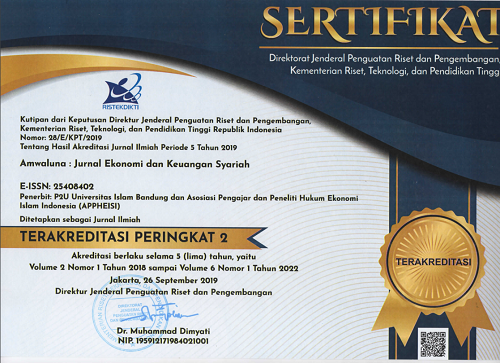DIMENSI RISIKO BAGI KONSUMEN DALAM MEMBELI PRODUK HALAL
Abstract
Keywords
Full Text:
PDFReferences
Al-Ansi, A., Olya, H. G. T., & Han, H. (2018). Effect of general risk on trust, satisfaction, and recommendation intention for halal food. International Journal of Hospitality Management.
Ambali, A. R., & Bakar, A. N. (2014). People’s Awareness on Halal Foods and Products: Potential Issues for Policy-makers. Procedia - Social and Behavioral Sciences, 121, 3–25.
Annabi, C. A., Husein, M. U., & Hassan, F. (2017). Sharia Compliance in the Construction Industry : Is this Something to Build Upon ? Journal of Emerging Economies and Islamic Research, 5(1), 1–15.
Arsil, P., Tey, Y. S., Brindal, M., Phua, C. U., & Liana, D. (2018). Personal values underlying halal food consumption: evidence from Indonesia and Malaysia. British Food Journal.
Awan, H. M., Siddiquei, A. N., & Haider, Z. (2015). Factors affecting Halal purchase intention – evidence from Pakistan’s Halal food sector. Management Research Review, 38(6), 640–660.
Bonne, K., & Verbeke, W. (2006). Muslim consumer's motivations towards meat
consumption in Belgium: Qualitative exploratory insights from means-end
chain analysis. Anthropology of Food, (5).
Bonne, K., Vermeir, I., Bergeaud-Blackler, F., & Verbeke, W. (2007). Determinants of halal meat consumption in France. British Food Journal, 109(5), 367-386.
Fuseini, A., Wotton, S. B., Knowles, T. G., & Hadley, P. J. (2017). Halal meat fraud and safety issues in the UK: A review in the context of the European union. Food Ethics, 1-16
Hair, J.F., Hult, G.T.M., Ringle, C.M. and Sarstedt, M. (2017). A Primer on Partial Least Squares Structural Equation Modeling (PLS-SEM). Sage. Los Angeles.
Henderson, J. C. (2009). Islamic Tourism Reviewed. Tourism Recreation Research, 34(2), 207–211.
Henseler, J., Ringle, C. M., & Sarstedt, M. (2015). A new criterion for assessing discriminant validity in variance-based structural equation modeling. Journal of the Academy of Marketing Science, 43(1), 115–135.
Jafari, J., & Scott, N. (2014). Muslim world and its tourisms. Annals of Tourism Research, 44, 1–19.
Marco, T. (2011). The application of Halal in supply chain management: in‐depth interviews. Journal of Islamic Marketing, 2(2), 186–195.
Oktadiana, H., Pearce, P. L., & Chon, K. (2016). Muslim travellers ’ needs : What don ’ t we know ?, 20(124–130), 2015–2017.
Olya, H. G. T., & Al-ansi, A. (2018). Risk assessment of halal products and services: Implication for tourism industry. Tourism Management, 65, 279–291.
Rammal, H. G., & Zurbruegg, R. (2007). Awareness of Islamic banking products among Muslims: The case of Australia. Journal of Financial Services Marketing, 12(1), 65–74.
Ryan, C. (2016). Editorial. Tourism Management Perspectives, 19(PB), 121–123.
Zakaria, N., & Abdul-Talib, A. N. (2010). Applying Islamic market-oriented cultural model to sensitize strategies towards global customers, competitors, and environment. Journal of Islamic Marketing, 1(1), 51–62.
DOI: https://doi.org/10.29313/amwaluna.v4i1.5220
Refbacks
- There are currently no refbacks.
Editorial Office:
Syariah Faculty, Universitas Islam Bandung
Jalan Tamansari No. 24-26 Kota Bandung

Amwaluna : Jurnal Ekonomi dan Keuangan Syariah is licensed under a Creative Commons Attribution-NonCommercial-ShareAlike 4.0 International License.







